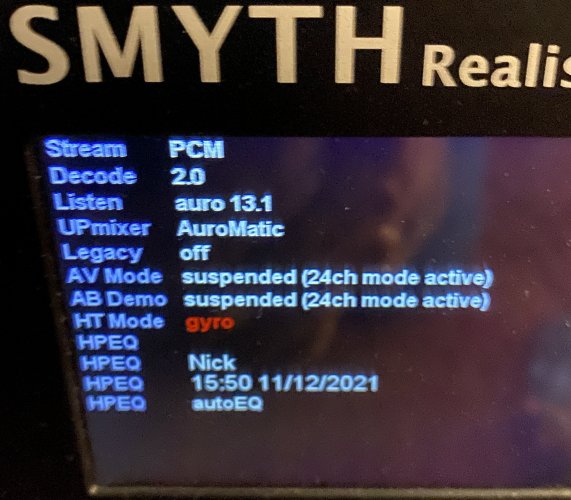dsperber
500+ Head-Fier
- Joined
- Jul 27, 2005
- Posts
- 800
- Likes
- 326
All very interesting as well. I see that you've enabled 24-ch support in the A16, which I have not done. I've only received 9.1.6 as Atmos, which I knew was my own choice but it was perfectly fine because I didn't know there was content out there that delivered even more, e.g. 15.1.8 from "The Witcher".So I actually do both and have not had issues with either. My external sources are all gaming devices and I run those to my tv because they all support HDMI 2.1 which I would lose if I connected directly to the A16. I also use the internal apps on my tv and have no issues with Atmos there either. I just tested using the built in Netflix app playing episode 1 of The Witcher, and was getting 15.1.8 fed to the A16 over eARC. I don't use the internal apps often as I have my streaming boxes connected directly to the A16's HDMI 1-4 ports and I prefer using them.
Absolutely. He did mention that he has a cable from 2010 that is not a 2.0 cable (which makes sense since memory tells me 2.0 officially launched in 2012 or 2013), I sort of sped through his post and didn't seize on that. My assumption is that is the source of all of his Atmos/eARC issues.
I will re-test again, but first will enable 24-ch support. I wouldn't expect it to be relevant, but who knows.
Note that the only reason I was using Netflix on the C9 as oposed to using it from my Roku, ATV4K or Shield Tube was because of the information stated in this AVS Forum post (scroll down a bit, and expand the "spoiler" to show the details) which addressed which streaming source option was "best". Regarding Netflix it said:
"Netflix- in light of recent issues with audio drops with Atmos on the ATV4K, I find it best to use your TV's native NF app, as it will be getting the same 15Mbps UHD stream the ATV4K does. If you haven't had this issue, the ATV4K is fine, or also the same is the 2019 Shield Pro (either one), so long as you set up framerate matching if you experience issues with that."
So I was just experimenting. And this also gave me another chance to play with eARC, my new A1080 AVR, my A16, etc. I'd already been playing with eARC from the Silicon Dust HDHomeRun app running on my LG C9 as a way of delivering locally-decoded AC-4 DD5.1 audio for the new ATSC 3.0 OTA channels here in LA. These are now available to me through the network-based SD HDHR Flex 4K OTA/ATSC tuner I bought in December that supports both ATSC 1.0 and 3.0.
And that's how I ran into this issue, using "The Two Popes" on Netflix app on the C9, with my A16 still set at 16-ch.
As an aside, I mention that I am back to my "original normal" cabling arrangement, which passes my Roku Ultra 2020, ATV4K 2019 and Shield Tube 2019 into three HDMI inputs of my A16. The fourth HDMI input of the A16 is for audio-only HDMI2-out of my Oppo UDP-203 (used for listening to headphone audio from DVD/BluRay discs played on the 203). Main video-only HDMI1-out of the 203 goes to HDMI2-in on my A1080 AVR. All the other three audio/video sources into the A16 have their video passed-through its HDMI-out and into HDMI3-in on my A1080 AVR. And HDMI1-out of the A1080 AVR goes to the LG C9.
I also have my Windows Media Center extender (aka "cable box" for HDTV) going into the external HDMI input of the 203, where 720p/1080i HDTV gets deinterlaced and upscaled to 2160p and then its audio/video delivered via main HDMI1-out to the A1080 AVR. I normally don't have the A16 powered on when watching ordinary TV. This allows me to watch 5.1 audio TV through my 2.0 speakers managed by the AVR, which I have set as "2ch-stereo" when sourced for HDTV->203->AVR.
Also, with the TV still connected to the HDMI1-out of the AVR this also supports eARC from TV app to the AVR, for delivery again through the 2.0 speakers. This eARC-mode audio is again played through "2ch-stereo" option of the AVR (which down-mixes 5.1 audio from a TV program to 2.0 for listening).
Only when I want to listen to anything through A16/headphones do I then power on the A16. The four HDMI inputs of the A16 support the four possible sources for audio/video. The three streamers provide both source audio/video, and the audio-only coming from the 203 is for listening to something from HDTV via headphones.
So no cable switching needed for any of the above situations. The only cable switching ever needed is if I want to listen to a TV app via eARC audio and also through headphones. Then I have to physically move the HDMI1-out AVR-end of the HDMI cable going to the TV over to the HDMI-out of the A16. And... temporarily connect a second HDMI cable from any input on the A16 to the HDMI-out of the AVR, to get Atmos instead of just 5.1 audio.
Nevertheless I will re-try the whole eARC story again, after putting my A16 into 24-ch mode. I didn't do that before because I never had a personalized PRIR for Atmos. I've only been using my AIX 7.1 PRIR for the ear-level speakers, and adding in the BBC speakers for everything. Since they were not personalized anyway I just stayed with 9.1.6 via 16-ch configuration. But I will change that now, on the off-chance it somehow affects eARC and Atmos from Netflix on the TV app.














